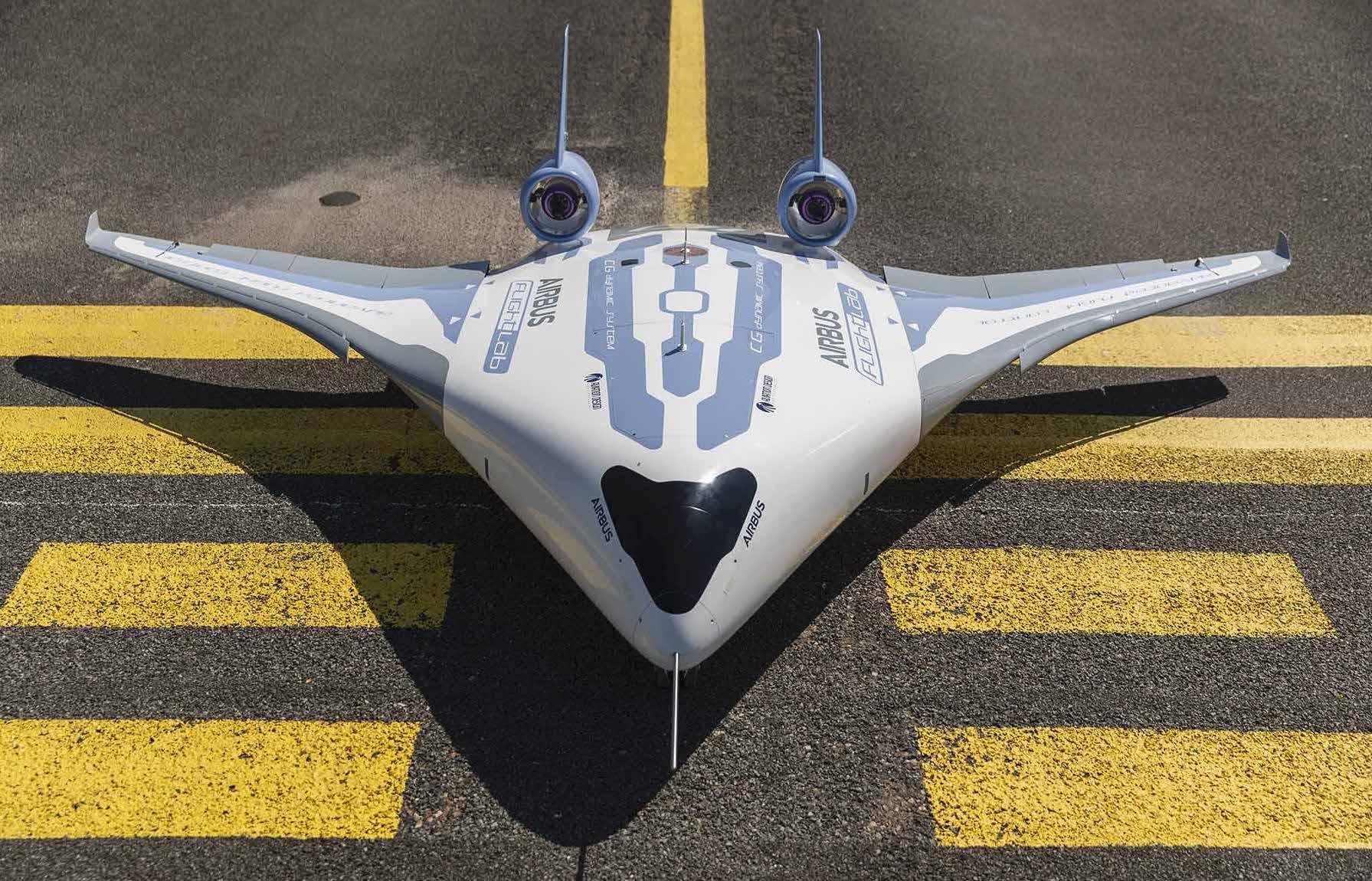
Singapore - As it becomes clearer that disruptive new airliner configurations will be one of the few ways of meeting the reduced emissions targets of the future, Airbus has revealed it is flight-testing a scaled blended wing body (BWB) technology demonstrator.
The BWB flying wing configuration, originally conceived by McDonnell Douglas in the 1990s prior to its acquisition by Boeing, offers potential operating efficiency improvements because lift can be generated across the fuselage. Additional benefits include reduced form drag and greater space above the wing for more efficient higher bypass engines or other propulsion systems.
Dubbed the Maveric (model aircraft for validation and experimentation of robust innovative controls), the Airbus demonstrator is 6.5 ft. long with a 10.5 ft-span wing. Powered by twin podded model aircraft turbine engines mounted above the aft deck of the 24.2 sq. ft area wing, the aircraft first flew in June 2019 at an undisclosed location in central France. Maveric is still being flight tested says Jean-Brice Dumont, executive vice president of engineering for Airbus.
Designed specifically to evaluate flight control systems adapted for delta wing designs, the flight tests will be followed by a second round of studies to evaluate wider aspects of the configuration including safety, manufacturability, airport compatibility, maintenance and support. “Let’s be clear we are studying this as an option,” says Dumont. “We have already learned a lot and tests have helped us understand the flight behaviour of this kind of configuration in a real flight condition. So far we have a green light which is why are unveiling it, and we are continuing with a more extensive study.”
Airbus believes an initial single-aisle sized BWB could potentially provide up to 20% lower fuel burn than current tube-and-wing designs. Although Boeing, and latterly Lockheed Martin, have targeted blended designs at military and cargo roles after more than two decades of research, Airbus says recent technology advances could make it more attractive in the near to mid-term. “What makes us wish to revive the BWB now? Some technologies have improved; we can make the aircraft lighter and our flight controls and computing capabilities are one level higher. That means we can face the challenges at least a level higher than before.”
However, Dumont says the real driver is the environmental concerns facing the industry. “The pressure we are under and the fact we need to disrupt to reach emissions objectives in 2050 forces us to drive down avenues we wouldn’t have gone down earlier. That’s because the equation was not resolvable and now we believe it is.” Dumont adds BWB configurations are also particularly attractive because they can more easily support non-conventional hybrid electric and, perhaps ultimately, all-electric propulsion systems.
Airbus says the Maveric forms part of a broader group of advanced technology studies which will help guide potential future product development. Some of these projects, including the EcoPulse distributed propulsion demonstrator unveiled last year, will influence decisions on which technology may be tested in a larger scale demonstrator. “To take this concept further we will need to fly a ‘Scale 1’ or larger demonstrator, but before that, we must answer questions about airport interface issues and the propulsion system,” says Dumont.
“What’s the best fit for the BWB? Right now we have two podded engines but is it the right formula? In parallel, we are testing the EcoPulse with Daher and Safran in France which is teaching us quickly about flight controls and power controls for distributed propulsion. So, we are converging this into a potential product. I’d say the next step would be flying this at a larger scale, but at exactly what scale and when I don’t know.”
Under the EcoPulse project Daher, Airbus and Safran plan to fly a modified TBM 900 turboprop as a distributed propulsion demonstrator by mid-2022. Although the aircraft will retain its standard nose-section engine and propeller the TBM will be modified with three small propellers on each wing. Each will be driven by a 45-kW Safran ENGINeUS electric motor, fed by batteries or an APU. Airbus is contributing battery technology and aerodynamic modelling.
One key question is whether the generally windowless cabin of a BWB can be made attractive to passengers. Boeing’s long-running BWB studies, some of which were conducted with NASA under the X-48 project, focused mostly on flight characteristics but also included many potential passenger and cargo configuration evaluations. The majority of these favoured freight over passenger roles due to issues associated with passenger acceptance and safety concerns, but Airbus believes technology concepts that include virtual screens for situational awareness could make BWBs acceptable to the traveling public.
“We need to come with disruptive options and enter service at the earliest possible date to bring benefits by 2050. The clock is ticking,” says Dumont.






Comments
It has always been the bride's maid, never the bride for a lot of reasons. Pressurizing the non-circular cross sections will be heavy. Composites may decrease the penalty, but a lighter circular cross section can be fabricated from those same materials. Like all tailless aircraft, maximum performance from the wing requires negative pitch stability. This has never been attempted on a commercial transport. Even then, high lift devices will be limited mainly to leading edges.
The big BWB concept killer for commercial transport applications is the lack of a constant cross section making stretch versions difficult to impossible virtually eliminating model families that share engineering, tooling, parts manufacture and support. It will also make the interior vastly more expensive due to the lack of common panels etc.
I was much more impressed with the "flying V" concept if the aero can be worked out with the highly swept thick cross section fuselage/wing. At least there is a path for a model family and a significant portion of the interior will use common parts.